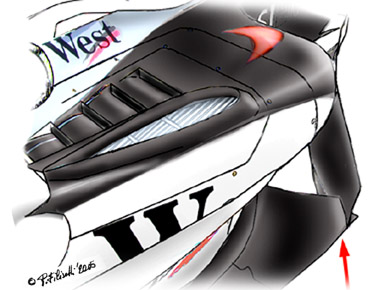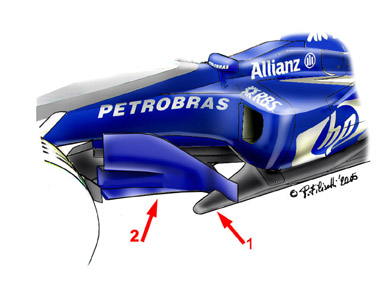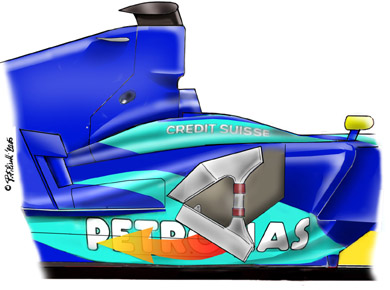Sunday, March 20, 2005
MALAYSIAN GP 2005 TECHNICAL ANALYSIS

McLaren MP4-20 - strengthened barge boards
In Australia Kimi Raikkonen lost his right-hand barge board through contact with a kerb. So, for Sepang onwards, the mounting of this element on the front bottom edge of the sidepod has been strengthened, by increasing its width and adding layers of carbon fibre around it. Note also how the chimneys on the sidepod are increased in section due to the increased cooling needs at this track.

BAR 007 - additional barge boards
An evolution of BAR's barge board and turning vane concept for Malaysia. Previously the front-axle level barge boards were separated from the turning vanes in front of the sidepods. Now the two are connected by additional low, tiny barge board, similar to that seen on the Williams. The changes improve the airflow management underneath the car, and engine cooling, directing more air to the sidepod intakes.
An evolutionary design for Sepang, sporting a much deeper central spoon profile (red arrow) than its predecessor. The spoon now features a continuous curve, rather than the partially flat section seen before. The extremities of the wing are now slightly higher than the central section, improving the efficiency of the endplates. A new flap (black arrow) has been added with wider sections close to the endplates, producing additional downforce.

Williams FW27 - new barge boards
An aero development for Sepang in the form of new barge boards (2), coupled with the horizontal, knife-blade profiled turning vanes (1) already seen in Melbourne. The change improves airflow management in this area, increasing cooling capability - paramount at this race. It should also increase the stability of the FW27, which has looked somewhat nervous over bumps and under braking.

Red Bull RB01 - sidepods and chimneys
A more traditional cooling solution than seen on the Sauber in Malaysia. Already large chimneys have grown even further to ensure adequate heat dissipation in the extreme temperatures at Sepang. Despite the chimneys' huge volume, their design does not appear to significantly disrupt airflow to the rear of the car.
The C24 features sidepods with an extremely narrow bottom section - a design feature great for improving airflow management and downforce, but not so great for engine cooling (and hence reliability). The answer? Innovative V-shaped radiators, allowing for reduced sidepod height and excellent cooling - so good in fact that no further gills have been added for the very hot Malaysian race.

